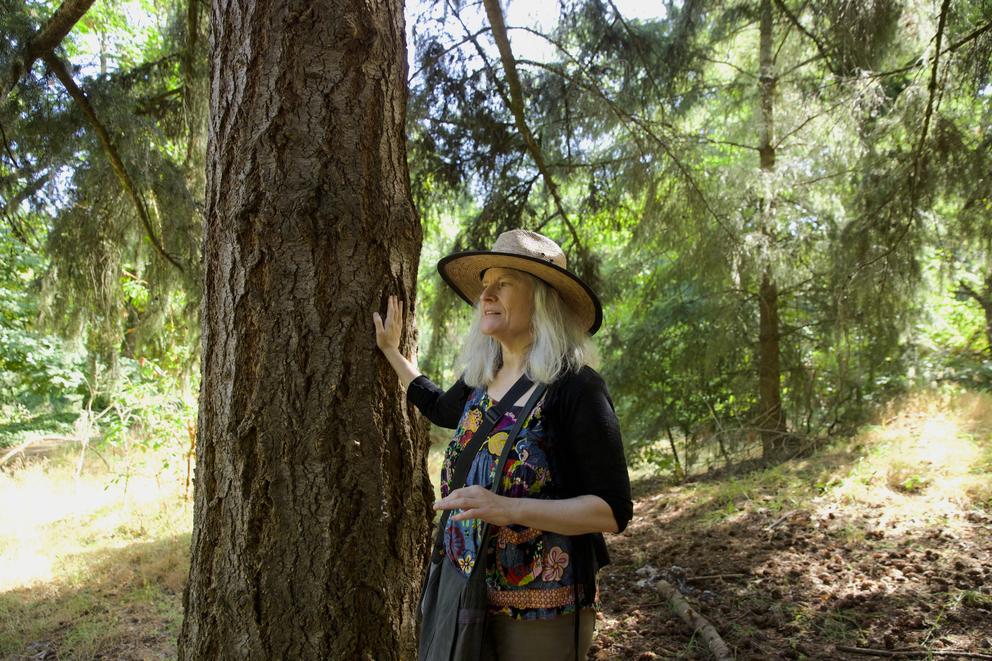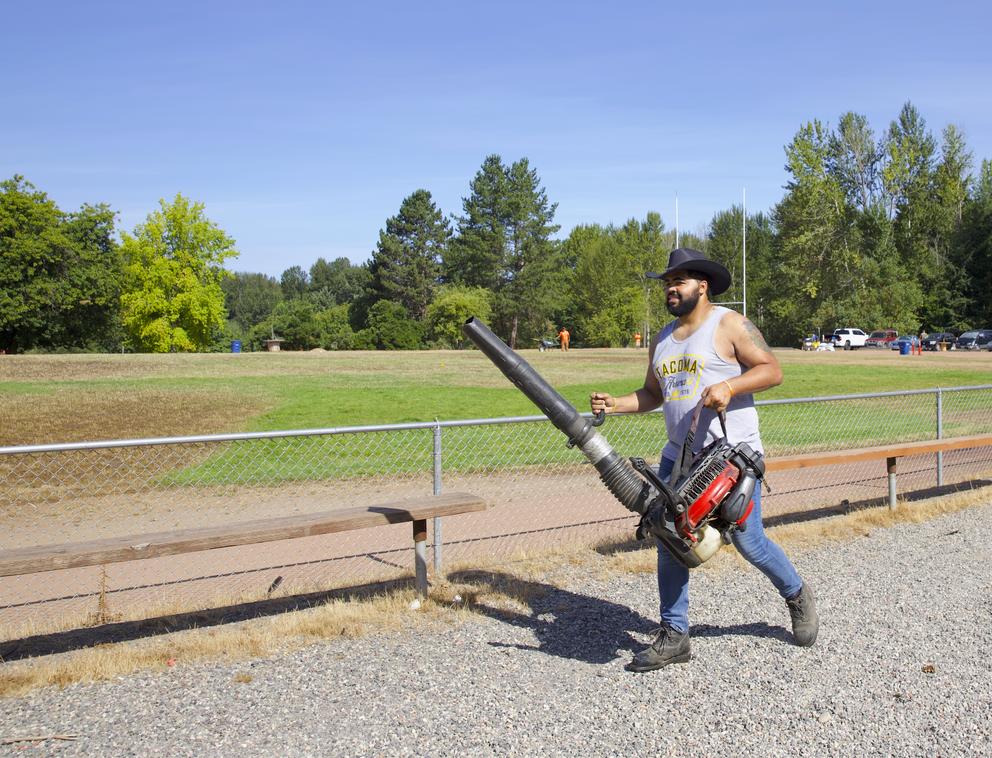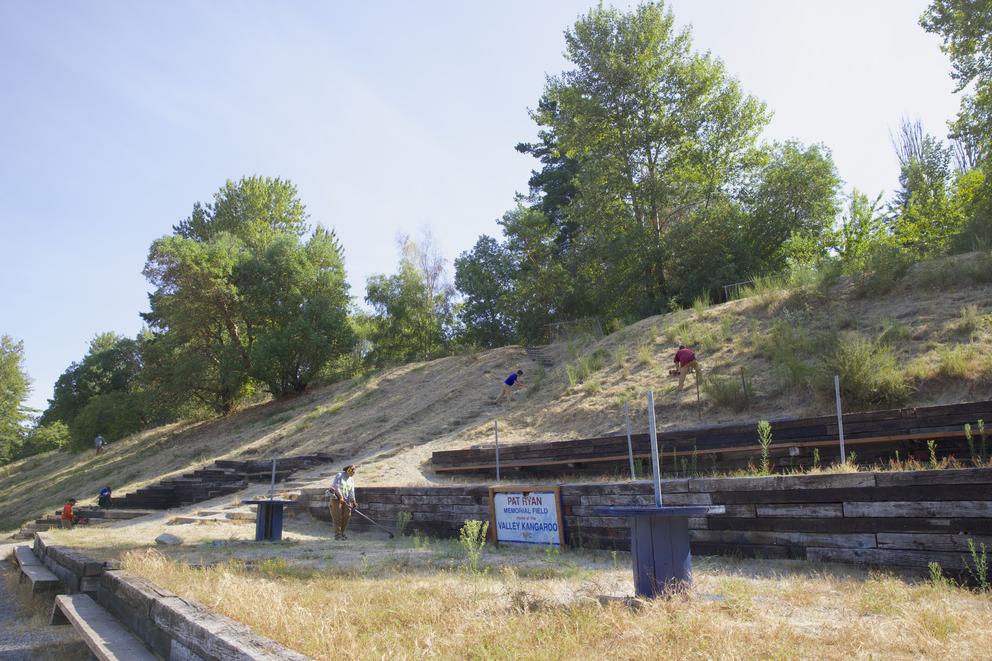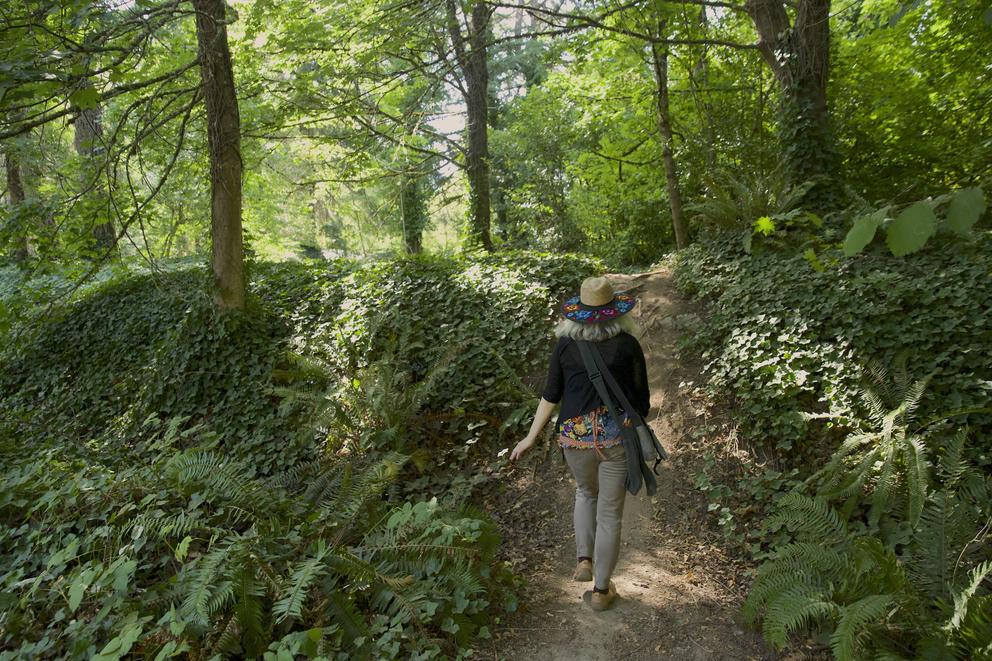A roughly 220-acre forested refuge in industrialized South King County, the park lights up aerial maps like an emerald beauty mark. Its tall conifers immediately soothe Maxwell Vassilakis, a county librarian, who revels in the relative quiet of her mile-plus park detour.
“The air is fresh and wonderful and there’s just this sense of happiness. And then I leave and have this bad feeling,” she said, bemoaning SeaTac’s generally sparse tree canopy.
Maxwell Vassilakis, whose parents both died from lung disease, said she appreciates that the forest buffers air so polluted class action lawsuits and county research projects alike linked it to greater incidences of disease among the area’s largely BIPOC and low-income residents. The park cools one of the hottest parts of the county, sheltering ecological jewels like one of the region’s last peat bogs. It also happens to be one of the area’s few recreational hubs, serving mountain bikers, disc golfers, soccer and rugby players, and even Olympic BMX cyclists.
None of the Port of Seattle-owned park’s features are guaranteed long-term. The City of SeaTac leases use of and access to North SeaTac Park property through 2070, but the Port reserves the right to develop 55 of its acres near the airport at any time. What happens in that acreage inevitably affects the rest of the park.
As one of the Puget Sound region’s biggest economic drivers, the airport faces constant pressure to continue expanding to accommodate passenger increases. It’s also one of the country’s most land-constrained major airports, leading staff to consider replacing scarce forested acreage with pavement even as they otherwise commit to improved sustainability.
That ongoing tension has sometimes strained the Port’s relationship with airport-adjacent communities, where locals argue the port must do more than compensate for past harms: It must also protect the environment that remains during a climate crisis. Maxwell Vassilakis, who helped create Defenders of North SeaTac Park, has rallied thousands to protest development in and around the park, starting with successfully reversing a 2021 employee parking lot plan.
While port officials assert they have no current development plans for the park, interviews and records requests show limited public access to long-term strategic plans, off-the-record advisory meetings and port consultants pushing back on recent research linking airport operations to increased pollution. Residents like Maxwell Vassilakis have also surfaced documents showing the port has previously developed areas it suggested would remain open space.
Politicians have started negotiating legislation that could make it easier for residents and their growing set of government allies within and beyond the Port to permanently protect the embattled forest. But Maxwell Vassilakis worries possible wins — like anticipated language in a shutdown-delayed Congressional bill reserving the park for recreation — won’t be enough.
“All of it can be developed eventually,” Maxwell Vassilakis realized. “That’s why public pressure is needed.”
Hard-won open spaces
The Port displaced nearly 1,000 acres of farms when it broke ground on SeaTac Airport in the 1940s — more than enough space to serve 500,000 passengers annually. But as neighborhoods settled in along the perimeter, the airport kept expanding, and so did its noise footprint. Residents’ frustration over noise pollution eventually reached a boiling point that could be relieved only with a park.
Maxwell Vassilakis explained this while walking around North SeaTac Park one Saturday, shouting above present-day plane shrieks and gesticulating at a master plan map from the mid-’70s. It depicts how the Port planned to placate neighbors who’d had it up to here with jet noise.
At least 7,000 residents had petitioned the Port to buy out neighboring homeowners. Others sued for millions in compensation. Eager to stem the bleeding, the Port and King County corralled Federal Aviation Administration grant funding in 1973 to put sonic space between residents and the airport.
The Sea-Tac Communities Plan of 1976 concluded the Port would purchase “noise-affected” property from homeowners across 481 acres, including 576 homes north of the airport; insulate many more houses; and turn acquired lands into a noise buffer primarily “devoted to open-type uses.” The plan’s map labels all of present-day North SeaTac Park as open space — though development has encroached into some other similarly labeled Port properties in the years since.
Residents began planning North SeaTac Park, but it wasn’t until the City of SeaTac incorporated in 1989 that a vision took shape. In 1991, King County and SeaTac wrote a park master plan to make use of an “abandoned landscape.” That year the City of SeaTac leased a 14.5-acre section of park space, including the community center, for 50 years, and in 1994 leased an additional 205 acres for recreational use; that lease now extends through 2070.
Many parks in the region are similarly the result of community activism, Maxwell Vassilakis said purposefully. “There are so many people who need [parks] and resources are unjustly distributed,” she said.
But in 2002 the Port and city amended the recreational lease to give the Port the option to develop “certain Port property adjacent to North SeaTac Park” with a few months’ notice in exchange for permission to build a maintenance facility and funding for a trail. The “certain property” was actually a 55-acre section within the park.
Port representatives stress that they have no plans to develop the area, but residents who use the 55 acres today fear that their access to these, and eventually others, could quickly disappear.
Park paranoia
Along her path, Maxwell Vassilakis spotted a friendly face near the park’s heavily trafficked BMX track. Jon Brooks, president of the Valley Kangaroos Rugby Club, was headed to the rugby pitch — located within the 55-acre developable section — where the social club’s semi-annual field work party was underway.
The Valley Kangaroos have had an exclusive special-use permit and gate access to Pat Ryan Memorial Field for three decades. They lease directly from the Port, which removed their field from the City of SeaTac’s park lease in 2000. Dozens of adult players — many of them immigrants — and at least 250 Liberty High School students don’t have to compete with other field users for access the three days a week they play and practice.
As part of its use agreement, the club does all maintenance work itself. “It’s very much Bad News Bears style,” Brooks said, pointing to a few athletes hacking away at invasive blackberry bushes, “but green recreation is so hard to find in this city, especially in the South End.”
Club leaders regularly let guidance counselors know there’s a place for kids to meet role models, make new friends and get their aggression out.
Garrett Mitchell, a wing, said he’d be pissed if they lost access to the field. “I’ve been playing on this field since I started rugby here at 18, and I’m 26 now, and I just have a lot of good memories here. Not only that, they’d be taking it away from all the kids, too,” he said, jeopardizing chances to be seen by college and major league scouts.
Development would threaten more than rugby. The plot features a botanical garden and dozens of miles of mountain biking and walking trails. It intersects with Tub Lake, an endangered peat bog, and houses the headwaters of Miller Creek.
“The value of the rugby community, the bike community, the bog? You just can’t replace those,” Maxwell Vassilakis said.
Despite the Port’s assertions and recent funding for restoration projects in the park, users remain concerned about development. The Port not only adjusted lease agreements for the 55-acre section explicitly to allow future development, but has published planning documents suggesting future development in the park.
Authors of a 2020 Real Estate Master Plan recommend considering turning 340,000 square feet of the 55-acre section into airport-supporting facilities like a food innovation center. Port staff also recommended turning 11 acres of it into an employee parking lot, as part of the $4 billion Sustainable Airport Master Plan process started in 2014 — until Maxwell Vassilakis, SeaTac councilmembers and community groups and even Port environmental staff intervened.
When Maxwell Vassilakis heard the Port was considering replacing an 11-acre section of North SeaTac Park with an employee parking lot, “it felt like watching an assault,” she said.
Defenders of North SeaTac Park pored over planning documents and calculated that more than 100 acres of treed Port land (in addition to the 11 acres) were marked for potential development. The group’s petition calling for a reversal on the plans received 2,400 signatures, and the Port abandoned the parking-lot plan in 2021 under FAA recommendation.
Port Commissioner Fred Felleman said he wasn’t surprised by the backlash. “I don’t refute that we need land. We just don’t need this land,” he said recently of the 11-acre section. “This land is their land.”
The latest master plan, based on forecasts of significantly increased passenger demand in the coming decades, has stalled in a years-delayed FAA environmental analysis, and the Port has meanwhile kept tight-lipped about its health impacts to nearby communities citing “deliberative process exemption.” The FAA and Port expect to publish an environmental assessment in late 2024.
When residents and some SeaTac officials have pushed for additional information, they’ve been told none is ready to share. A draft version of the Port’s real estate plan was supposed to be ready in July, SeaTac Deputy Mayor Senayet Negusse said, but the Port says it will publish before the end of the year. Emails produced from records requests show that Port staff promised internally that information regarding the Port’s development plans within the park would “remain confidential” until after the SAMP environmental assessment became public.
More than 3,200 people have since signed Defenders’ newer consensus petition calling for three things: protection of North SeaTac Park as a park in perpetuity; a moratorium on tree removal and green space development on public lands within two miles of SeaTac Airport; and a plan to restore the park and surrounding forest.
“Right now, there’s a lot of hope for the park,” Maxwell Vassilakis said.
Turning tides
After years of discussions, SeaTac’s city council submitted a letter to the Port in May 2022 asking the Port to explore how it might sell the land to the city. An advisory committee released a joint statement a few months later confirming the parties would nail down a long-term plan for the park.
The two parties have been discussing the future of the park since 2018, with SeaTac open to everything from zoning changes to a covenant. But this spring, the Port for the first time entertained the idea of selling any section of the park to the city.
The turning point coincided with congressional-level language in the new draft FAA Reauthorization Bill, championed by Sen. Maria Cantwell and Rep. Adam Smith and crafted with help from Port staff, that would lower barriers to such a sale. The language does not specifically call out North SeaTac Park, but is worded such that it could reasonably apply only to this particular park, Felleman said.
The Port bought the park with FAA grant funds that require land to be resold at market value or else jeopardize future grant funding. The FAA in fact recommended that the Port maximize the revenue value of its lands in a 2016 audit questioning the lease agreement, though the Port’s Aviation Division contended a park was the best use of the space.
An FAA spokesperson confirmed the FAA’s position that the port should sell at fair market value if it chooses to sell, and that if it does not it should prioritize options that generate higher revenue.
But the draft bill language enables keeping the park in permanent recreational use, and paves the way for a sale to SeaTac below market value. The federal House passed its version of the bill in June. The Senate, facing a federal government shutdown, voted on Tuesday, Sept. 26, to extend the current FAA Reauthorization while it deliberates on its version of the bill.
Residents rave about the legislation, but worry it wouldn’t guarantee total park protection. Felleman is more optimistic.
“If that legislation passes, I think there's no chance in hell that this property is going to be anything but a park,” he said. “One way or the other, it'll be permanently protected.” But he stresses time is of the essence for a sale. “Commissioners and city councilmembers come and go, and the needs of the city and the airport only grow.”
Port commissioners have communicated, either through campaign promises or by signing petitions like Maxwell Vassilakis', to protect the park, but Negusse struggles with not having the Joint Advisory Committee’s commitments in writing.
“A personal challenge for me is that we’re not documenting our notes, we’re not documenting our progress,” she said. “I know these are private meetings and not public, but I think it’s important for us to have a record of the conversation, the discussion, the updates coming out.”
Kwon said this was intentional, to give attendees room to discuss matters frankly, and that it was a Port decision to move conversations about the park’s development to these meetings. Felleman, however, noted he and some others would be comfortable with the majority of the advisory group’s meetings being open to the public.
Port Commissioners like Felleman and staff acknowledge North SeaTac Park is valuable. “The airport does need to use the land around the airport to its best purposes. But sometimes those best purposes are open space,” said Clare Gallagher, who manages external relations for airport cities.
But they also struggle to marry sustainable aspirations with economic goals.
“We run a big smelly organization,” Felleman said. “I see the job of the commission as minimizing the impacts and maximizing the benefits, but there will always be impacts.”
Gallagher said the Port increasingly responds to community pressure, referencing a recent effort to reduce tree removal under flight paths. Staff say they think the public isn’t aware of how much work they put into environmental restoration.
Felleman doesn’t think protecting every piece of forest covered by the consensus petition is possible, noting he’s already aware of ideas for a bike path that would intersect them.
“I’m not exploring the ability to protect everything right now. … These are, like, postage stamps compared to [North SeaTac Park]. They’re broken up and they don’t have the ecological or community value I think that this does. And I’m not oblivious to the fact that we need to develop property,” he said. “I think [the park] is actually something that can be accomplished.”
“To the credit of the community, though,” he added, “they’ve been pretty damn clear on this issue.”
Backstops
In addition to the FAA Reauthorization, the Port recently made promises residents hope will blunt development aspirations in North SeaTac Park and beyond.
The Port adopted a new land stewardship order in June that, while ambiguously written, encourages the Port to preserve forest and factor the environment into development plans, Port staff and commissioners said. Staff are also working on an environmental equity mapping tool to further identify where airport communities need more protections, which could help hold it accountable for environmental justice impacts. A new aviation land-stewardship plan may be discussed in community meetings this fall.
Maxwell Vassilakis said she is excited about these promises, but worries about what might happen without continued pressure. After three decades living in Washington and organizing 57 forest work parties, she’s moving home to the East Coast to be closer to family, leaving a grassroots organizing and forest-restoration work party gap in her wake.
“There needs to be citizen follow-up forever, even if [the FAA Reauthorization] goes through,” Maxwell Vassilakis said, pointing out new growth in one of her forest work sites. “We can celebrate that this happened. This is genuinely a good thing. But there’s no mandate that you have to save the park.”
“This is the beginning.”
Update: After publication, Felleman clarified his quote about the Port not needing specific park land to include not only the 11-acre space once considered for a parking lot, but the entire 55 acres in question.






